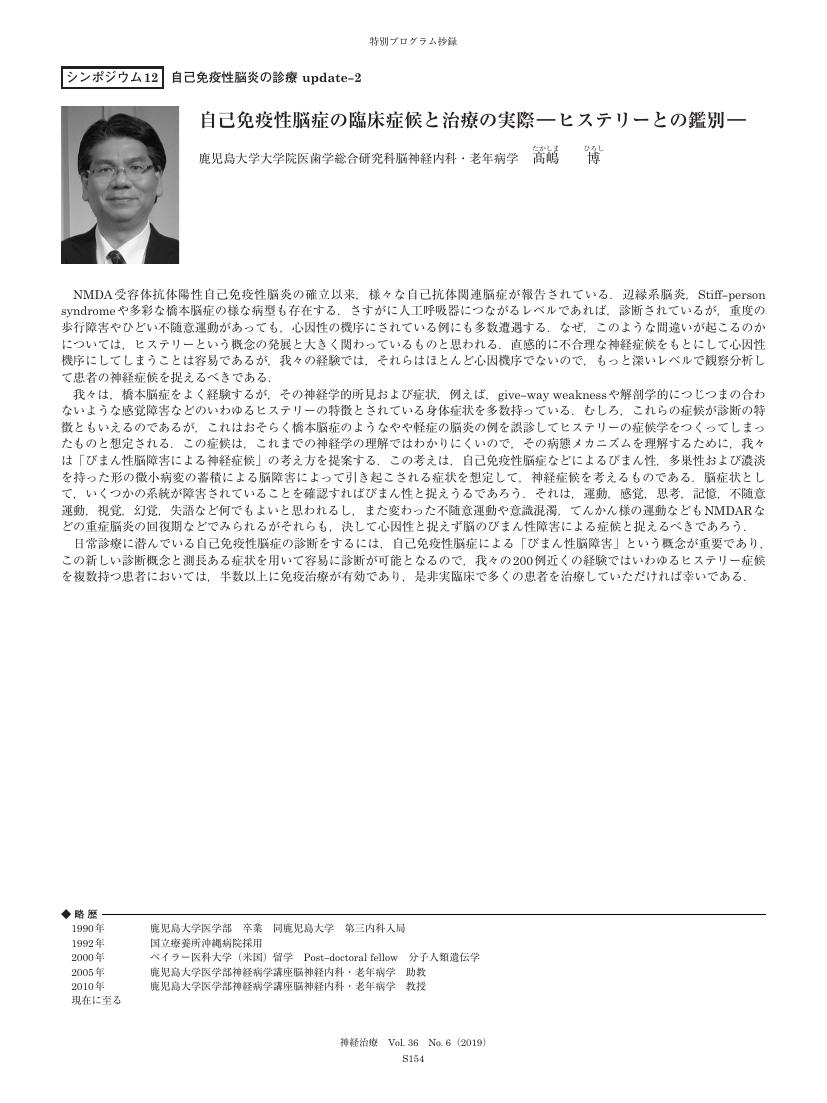2 0 0 0 OA 2.高齢者の手足しびれ感の診断のポイント
- 著者
- 吉村 道由 荒田 仁 出口 尚寿 髙嶋 博
- 出版者
- 一般社団法人 日本内科学会
- 雑誌
- 日本内科学会雑誌 (ISSN:00215384)
- 巻号頁・発行日
- vol.103, no.8, pp.1876-1884, 2014-08-10 (Released:2015-08-10)
- 参考文献数
- 5
しびれは個々でその定義が異なり,鑑別も非常に多い.高齢者においては,年齢に伴う動脈硬化性変化や骨性変化によりきたす疾患も多くみられる.診断をするにあたっては既往症や基礎疾患などの背景と伴に,発症様式,性状,部位なども重要となる.しびれのメカニズムを述べるとともに,末梢性,中枢性,部位別に分類してそれぞれの代表的な疾患の特徴や,診断をすすめるうえでの検査について述べる.
2 0 0 0 Letter to the Editor:Reply
2 0 0 0 OA T細胞型悪性リンパ腫を併発した神経ボレリア症の1例
- 著者
- 永田 龍世 稲森 由恵 髙田 良治 池田 賢一 渡邊 修 髙嶋 博
- 出版者
- 日本神経学会
- 雑誌
- 臨床神経学 (ISSN:0009918X)
- 巻号頁・発行日
- vol.54, no.2, pp.146-150, 2014-02-01 (Released:2014-02-28)
- 参考文献数
- 16
症例は80歳男性である.両側性末梢性顔面神経麻痺,四肢筋力低下,四肢末梢・会陰部の感覚障害,尿閉,便秘,四肢腱反射消失をみとめた.バゾプレシン分泌過剰症(syndrome of inappropriate antidiuretic hormone secretion; SIADH),脳脊髄液細胞増多・蛋白上昇をみとめ,セフトリアキソンおよびステロイドパルス治療にて神経症状はすみやかに改善した.脳脊髄液CXCL-13上昇,血清抗ボレリアIgM抗体陽性より神経ボレリア症と診断した.経過中,SIADHの再燃と全身状態の悪化をみとめ,骨髄検査でT細胞型悪性リンパ腫が判明した.近年,ボレリア感染とリンパ腫の関連が報告されており,本例においてもボレリア感染がリンパ腫の発症機序に関連した可能性が考えられた.
1 0 0 0 OA 抗ganglionicアセチルコリン受容体抗体が陽性を呈した全身性無汗症の1例
- 著者
- 兒玉 憲人 﨑山 佑介 小迫 拓矢 武井 藍 中村 友紀 橋口 昭大 道園 久美子 松浦 英治 中根 俊成 髙嶋 博
- 出版者
- 一般社団法人 日本内科学会
- 雑誌
- 日本内科学会雑誌 (ISSN:00215384)
- 巻号頁・発行日
- vol.107, no.1, pp.95-102, 2018-01-10 (Released:2019-01-10)
- 参考文献数
- 10
42歳,男性.全身の発汗低下を主訴に受診した.起立性低血圧や頻尿を伴い,広汎な自律神経障害が示唆された.皮膚生検で汗腺及び血管周囲にリンパ球浸潤を認め,抗ganglionicアセチルコリン受容体抗体陽性が判明した.通常,同抗体は自己免疫性自律神経節障害(autoimmune autonomic ganglionopathy:AAG)の原因となるが,汗腺への直接作用は明らかでない.本症例には汗腺と自律神経節障害の両者の特徴が混在し,ステロイド治療が有効であった.
1 0 0 0 OA シャルコー・マリー・トゥース病に類似した三頭酵素欠損症の成人例
- 著者
- 山本 雄貴 松井 尚子 平松 有 宮崎 由道 野寺 裕之 和泉 唯信 髙嶋 博 梶 龍兒
- 出版者
- 日本神経学会
- 雑誌
- 臨床神経学 (ISSN:0009918X)
- 巻号頁・発行日
- pp.cn-000976, (Released:2017-01-28)
- 参考文献数
- 23
- 被引用文献数
- 2 6
症例は60歳男性.小児期より運動後の筋疲労感や褐色尿を自覚したが症状は軽微であった.45歳頃より両下肢遠位部優位の筋萎縮,感覚障害が進行した.神経伝導検査で軸索型末梢神経障害を呈し,シャルコー・マリー・トゥース病(Charcot-Marie-Tooth disease; CMT)が疑われた.55歳より横紋筋融解症を繰り返すようになり,血清アシルカルニチン分析と遺伝子検査から三頭酵素欠損症と診断した.三頭酵素欠損症は先天性脂質代謝異常症の稀な一型であるが,末梢神経障害を合併してCMTに類似した臨床所見を呈しうる.筋症状を伴う進行性の末梢神経障害をみた場合,積極的に本疾患を疑って精査すべきである.
1 0 0 0 OA 自己免疫性脳症の臨床症候と治療の実際―ヒステリーとの鑑別―
- 著者
- 髙嶋 博
- 出版者
- 日本神経治療学会
- 雑誌
- 神経治療学 (ISSN:09168443)
- 巻号頁・発行日
- vol.36, no.6, pp.S154, 2019 (Released:2019-10-25)
- 著者
- 荒田 仁 髙嶋 博
- 出版者
- 一般社団法人日本神経学会
- 雑誌
- 第60回日本神経学会学術大会
- 巻号頁・発行日
- 2019-05-08
- 著者
- 浜田 恭輔 武井 藍 﨑山 佑介 森山 宏遠 橋口 昭大 髙嶋 博
- 出版者
- 日本神経学会
- 雑誌
- 臨床神経学 (ISSN:0009918X)
- 巻号頁・発行日
- vol.58, no.1, pp.30-34, 2018 (Released:2018-01-26)
- 参考文献数
- 15
- 被引用文献数
- 3
症例は43歳男性である.緩徐に進行する構音障害と歩行失調,幼児退行などの精神症状,脳幹・小脳の萎縮性所見より脊髄小脳変性症が疑われ入院した.口内炎,陰部潰瘍,毛囊炎様皮疹,HLA-B51をみとめ,髄液IL-6高値より慢性進行型神経ベーチェット病と診断した.ステロイド,メトトレキサートの治療効果に乏しく,インフリキシマブで髄液IL-6の減少が得られたが症状は改善しなかった.本症例は広範に不可逆性の脳組織障害が生じた難治例と考えられた.脳幹の萎縮が進行する前に免疫治療を介入すべき疾患であり,精神症状と運動失調症がみられる症例では診断に有用である髄液IL-6を測定することが望ましい.
1 0 0 0 自己免疫性脳症のスペクトラムとびまん性脳障害の神経症候学
- 著者
- 牧 美充 髙嶋 博
- 出版者
- 医学書院
- 雑誌
- Brain and nerve (ISSN:18816096)
- 巻号頁・発行日
- vol.69, no.10, pp.1131-1141, 2017-10
1 0 0 0 2.高齢者の手足しびれ感の診断のポイント
- 著者
- 吉村 道由 荒田 仁 出口 尚寿 髙嶋 博
- 出版者
- The Japanese Society of Internal Medicine
- 雑誌
- 日本内科学会雑誌 (ISSN:00215384)
- 巻号頁・発行日
- vol.103, no.8, pp.1876-1884, 2014
しびれは個々でその定義が異なり,鑑別も非常に多い.高齢者においては,年齢に伴う動脈硬化性変化や骨性変化によりきたす疾患も多くみられる.診断をするにあたっては既往症や基礎疾患などの背景と伴に,発症様式,性状,部位なども重要となる.しびれのメカニズムを述べるとともに,末梢性,中枢性,部位別に分類してそれぞれの代表的な疾患の特徴や,診断をすすめるうえでの検査について述べる.
- 著者
- 髙畑 克徳 髙嶋 博
- 出版者
- 日本神経治療学会
- 雑誌
- 神経治療学 (ISSN:09168443)
- 巻号頁・発行日
- vol.33, no.1, pp.9-18, 2016
Autoimmune encephalopathies are clinically and immunologically heterogeneous disorders. Over time, many different types of autoimmune encephalopathy have been discovered. In such clinical situations, we often recognize that patients with autoimmune encephalopathy are often misdiagnosed as exhibiting functional psychogenic movement, conversion, or somatoform disorders. We clinically analyzed 63 patients (14 males and 49 females; age range, 15–79 years) diagnosed with autoimmune encephalopathy in our hospital from 2013 to 2015. Throughout this period we diagnosed almost no conversion disorders in our department. These patients were diagnosed using the diagnostic criteria for each disease, following clinical features showing neurological symptoms of brain origin, responsiveness to immunosuppressive therapy, the existence of known pathological antibodies, and/or history of human papilloma virus (HPV) vaccination. Fourty–two patients showed motor disturbance (weakness, paresis of extremities, or slower pinching) and 35/42 (83.3%) patients showed give–way weakness, indicating disruption of continuous muscle contraction. Fourty–four patients showed sensory abnormalities such as strong pain, deep muscle pain, dysesthesia, paresthesia, or fast neurologic pain. Surprisingly, most pain was distributed in manner that was not explainable anatomically, while some patients also showed patchy, stocking–glove, or localized pain. Seventeen patients exhibited involuntary movements such as tremor entrainment, dystonia, or coarse involuntary movement. In most patients, such motor, sensory, or involuntary movements were markedly improved with immunosuppressive therapies such as prednisolone, azathioprine, or immune adsorption therapy. We observed memory loss, PNES (psychogenic non–epileptic seizure), dissociative amnesia, hyperventilation, opsoclonus, epilepsy, or autonomic symptoms amongst our patients. Although give–way weakness, anatomically unexplainable pain/abnormal sensation, and strange involuntary movements were thought to be psychogenic, the presence of one of these three symptoms was indicative of autoimmune encephalopathy. As autoimmune encephalitis exhibits diffuse involvement with the whole brain, these symptoms were entirely understandable. Except for the presence of organic disease, most patients were classified into somatoform disorders (DSM–IV, ICD–10) or functional movement disorders. Without first excluding autoimmune encephalopathy, we propose that physicians should not diagnose somatoform disorders. Since autoimmune encephalopathy patients often possess so–called psychogenic signs, it is possible that such signs might be generated by autoimmune encephalopathy instead of somatoform disorders. In conclusion, we propose that give–way weakness and anatomically unexplainable pain/abnormal sensation are key symptoms of autoimmune encephalopathy. We hope that many patients with autoimmune encephalopathy will now be identifiable using our new neurological examination and that each patient can be given an exact diagnosis and therefore be administered with the appropriate treatments.
